Don’t Let Anyone Tell You You Can’t is the motto of DisCamino. It’s a voluntary organisation that helps wheelchair users and others with disabilities experience the joy of walking the Camino. Kurt Aguilar discovered for himself…
Don’t Let Anyone Tell You You Can’t – Que nadie te diga que no puedes – is the motto of DisCamino. It’s a voluntary organisation that helps wheelchair users and others with disabilities experience the joy of walking the Camino. Kurt Aguilar discovered for himself…
The stream is only about 30cm deep and a few metres wide, but when the clearance for your wheelchair motor is just 10cm and the creek is lined with uneven rocks and gnarled tree roots, it looks impassable.
That doesn’t deter Javier Pitillas and his cohorts at DisCamino. It’s an organisation that takes people with disabilities on otherwise unimaginable adventures. This included my trip in June on the Portuguese Way of the Camino de Santiago de Compostela in northwestern Spain.
Here I am, about a third of the way through a 100-kilometre route that seekers have taken for more than a millennium, facing a confounding roadblock.
But the journey is so important – to me and the volunteers helping out – that admitting defeat is not an option.
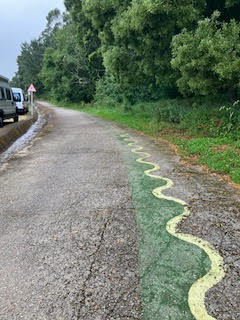
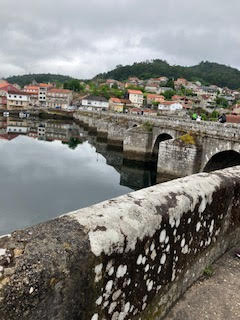
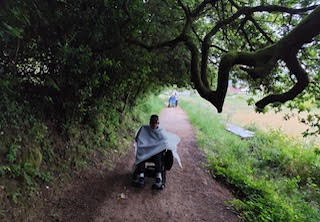
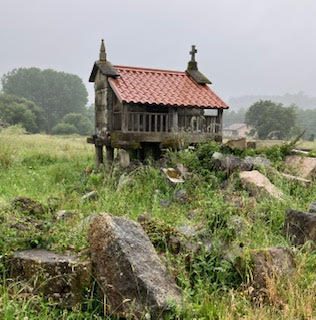
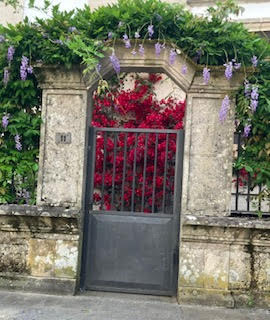
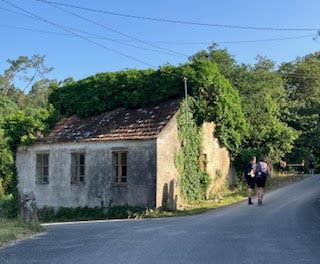
Pitillas and an aide use their arms as a makeshift sling to carry me to dry ground and return me to my chair. This has been brought along by a volunteer and my wife. We move along to tackle the next treacherous dip or steep rocky hill in our way.
Finding A Way For Those With Disabilities
The United States enacted the Americans with Disabilities Act, designed to bar all types of discrimination against disabled people, 35 years ago. Great Britain followed suit in 2010. Spain recently instituted a similar statute.
But obstacles still exist. Few, if any, groups do more to enrich the lives of people with disablilities than DisCamino. They are based in the Atlantic port city of Vigo, the capital of the region of Galicia.
DisCamino started 16 years ago. Pitillas was able to take Gerardo Fernandez, a young blind and deaf man, on the Camino. They went about 300 kilometres from Leon to Santiago on a modified version of the pilgrimage. They travelleed by bicycle on roads.
At the end of that venture, Fernandez asked that other people with disabilities get the opportunity to make the famous pilgrimage.
From this request came DisCamino, an all volunteer organization headed by Pitillas. He is a preternaturally good-natured retired policeman with the body of a long-distance runner and the energy of a puppy. The organization has taken more than 600 people with disabilities on about 150 trips. Many were along the Portuguese route of the Camino de Santiago de Compostela. Some of the nearly 100 volunteers will take disabled people on whatever trek they dream of. Be it mountain climbing, bicycling or traversing the Camino, Pitillas said.
Among the previous trips: climbing Spain’s highest peaks (both more than 11,000 feet) with people in mountain wheelchairs; traveling from Rome to Santiago on tandem tricycles; and circumnavigating Spain in adapted trikes – a trek of about 4,000 kilometres
“Our reward is happiness,” said Pitillas, a Spaniard who is fluent in English. “Seeing you happy makes us happy.”
The group’s motto is : ‘Don’t let anyone tell you that you can’t.’
But I thought I couldn’t.
Kurt’s Story
Because of a congenital illness that has limited my mobility since birth and that landed me in a wheelchair five years ago, traversing the Camino de Santiago had never crossed my mind.
The local Roman Catholic church in Santiago, which oversees the pilgrimage, has a formula for completing the Camino. The most important requirement is to traverse 100 kilometers (about 60 miles) on less-than-easy routes. That’s not something a guy who could walk maybe a half mile at his peak would ever entertain doing.
Last summer, though, a friend who walked the Camino told me that some people in wheelchairs had traversed the route as well.


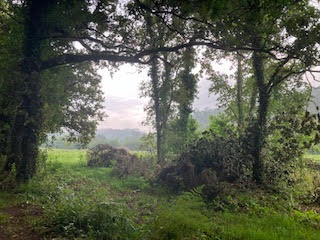
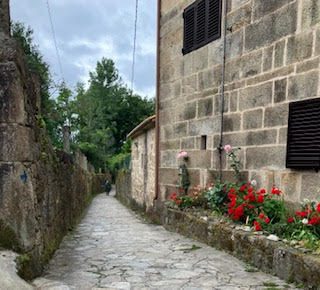
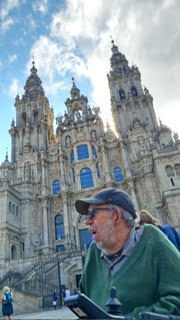
After a frustrating online search looking for somebody to assist my trip, I came upon DisCamino and was pleased to hear Pitillas describe the service.
DisCamino maps out a 100-kilometre route from Vigo north to Santiago, following the official Portuguese Way as much as possible. There are detours when the trail gets too steep or too rough or both. Volunteers walk with their clients every step of the way, offering assistance where needed. From finding the best track around potholes to pulling a chair out of a skid on gravel to a stream crossing.
DisCamino also ferries pilgrims (and their luggage) to and from their lodging place to the Camino route. Many electric wheelchairs don’t have the battery life to traverse entire stages of the trail in a day. And accessible accommodations are scarce in the region. So Pitillas and his team will transport pilgrims from the end of each partial stage to their lodging. Then back the next day to their previous stopping point.
Thanks to donations from private companies in the Vigo area and some money from the government, DisCamino offers its services free of charge.
Taking The First Step
I listened to Pitillas’ description of the service. Having heard many stories of the grandeur of the Camino de Santiago, my mind was set. I decided to take my lightweight Teyder power chair on the ride of its (and my) lifetime.
About half a million people annually make the pilgrimage to Santiago de Compostela. It is to pay homage to St. James (Santiago in Spanish). He was one of Jesus Christ’s 12 disciples, and is said to be buried in Santiago.
Christians have been making the pilgrimage for more than 1,000 years. It has morphed from a strictly religious experience. Today, people make the pilgrimage for a variety of reasons, some are religious or spiritual. But some go to experience nature’s beauty, some to challenge themselves, still others go to meet kindred spirits.
I took it because I realised that I could.
I had spent precious little time off the beaten path before tackling the Camino. The experience was eye-popping (and, at times, bone jarring).
Pitillas allows pilgrims to go at their own pace. My chair can go only about 15 kilometres on a charge. And we wanted to check out small towns along the way. So we opted for a very leisurely 12 days.
Most walking days followed the same pattern of an 8am departure. Then about three hours of wheeling mostly through the Galician countryside.
There was only one other wheelchair pilgrim on our trip. Dabiz Riaño is a research scientist who spent more than a decade in California. He returned to live in his native Spain following a 2008 diagnosis with amyotrophic lateral sclerosis (ALS),
It was his fourth Camino, but first with DisCamino. His previous three were with ALS groups. This trip was more authentic than the others he’s taken, which had less time on the trail, he said.
“Doing the Camino with DisCamino makes me feel healthy again,” he said.
Challenging Terrain
Our route is a patchwork of cobblestones, bricks, sand, gravel and dirt tracks. These range from perfectly smooth to stone-studded jaw rattlers. Asphalt that can be anything from highway quality to barely recognisable as such.
Among the obstructions are: deep V-shaped drainage ditches; stones sticking out of the ground; the occasional foray on a busy highway; seriously degraded stretches over which the chair (with me in it) has to be carried and, of course, crossing the creek.
When we reach the stream, Pitillas and an aide to Riaño each grab one of my legs. They support my back. I drape my arms around their necks and hang on (in a manoeuvre called the queen’s chair). I get carried to the other side. Meanwhile, my wife and a volunteer carry the wheelchair across. Pitillas and the aide return me to my seat to continue the journey.
It was one of several hairy moments on the trip.
On most days, there was a question as to whether my battery would last until the end of the stage. A particularly steep and rocky decline about 10 kilometres from the finish line had me wondering whether I would arrive safely at my destination or slip out of my chair onto the rocks and on to the hospital.
But the payoff was amazing.
The magical landscapes of Galicia
Receiving more than 1,500 mm of rainfall a year, Galicia nurtures a wide array of plants turning front yards into a rainbow of geraniums, hydrangeas, begonias, gladioli, fuchsias, roses and many more varieties. The annual rainfall total means you can get wet at any time of the year. We were lucky and had only two days with rain. On those days, the low clouds, mist on the hills and drops of moisture dripping off of the vegetation added to the mystical feel.
Roadsides are awash with blankets of tiny, delicate wildflowers. The air is freshened by the occasional scent of jasmine and the pervasive aroma of a recent rainfall. Chirping birds signal dry weather.
The mossy trees, lush ferns and stone-walled routes give the verdant countryside a look that at times appears too lush to be real.
Following 11 days of largely cloudy or wet weather, the day of our arrival in Santiago de Compostela dawned perfectly clear and sunny.
Our five-kilometre final leg had us arriving at the grand cathedral, our official destination, at about 10:30am.
It was there that we ran into an obstacle that not even the creative guides of DisCamino could overcome.
The Last Obstacle
The entry through the arch of the Xelmirez Palace is guarded by flights of stairs. Virtually no wheelchair can navigate this. It is where pilgrims traditionally pass into the cathedral square. Instead, we took a circuitous route and arrived via a much less inspiring way.
Riaño is working to fix that.He said the entry was ramped until the mid-1950s. It could easily be returned to its original state.
He participated in a recent demonstration at the gate and met with the town mayor to request the change.
“Restoring the original accessibility of this historic crossing would not only do justice to its functional value, but would also mark a turning point,” he told the Voice of Galicia news site. “If that threshold falls, the other steps in the city will fall under their own weight.”
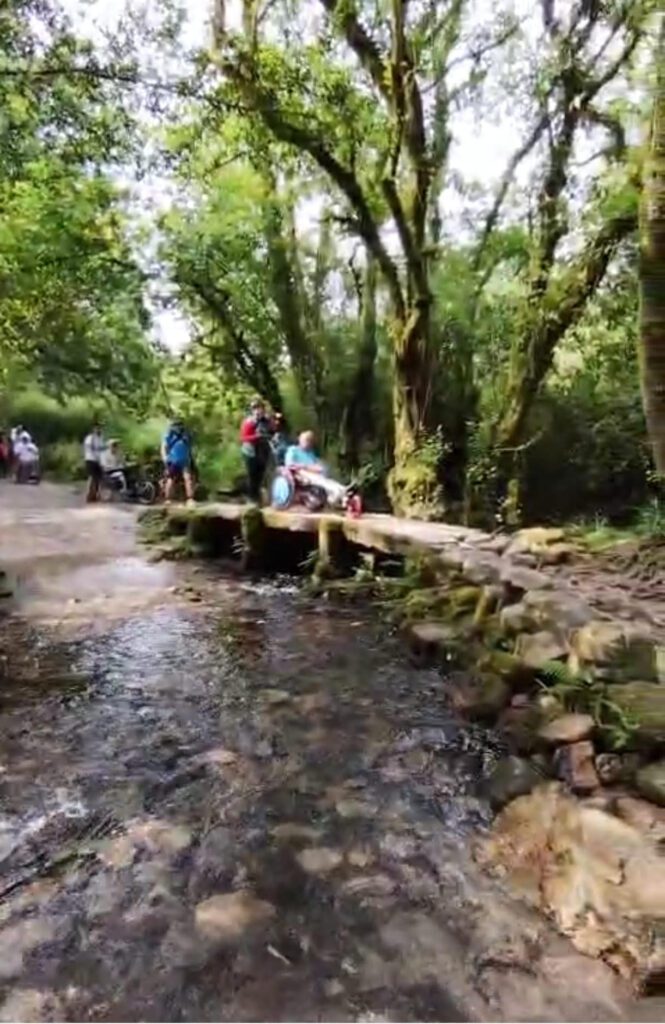
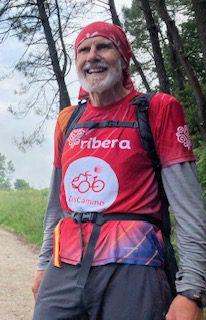
Despite the last-minute roadblock, Riaño was as overjoyed as I was with the trip. He called for a round of applause for the guides. This was at the emotional moment our group was set to break up at the end of the journey.
“DisCamino makes possible the impossible,” he said.
• To find out more, visit discamino.org, or call 618 241 124